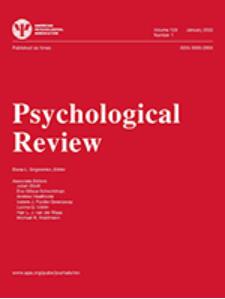g-距离:关于模型与人类异质性的比较。
IF 5.8
1区 心理学
Q1 PSYCHOLOGY
引用次数: 0
摘要
当模型的行为最接近单一(有时是平均的)经验结果集时,通常会对模型进行评估,但这种评估忽略了模型和人类行为都可能是异质的这一事实。在这里,我们开发了一种度量,g距离,它认为模型的充分性是模型表现出与它们所模拟的人类相似的行为范围的程度。我们将g定义为两个易于解释的模型充分性维度的组合:适应性和过度灵活性。我们将这一措施应用于非理性学习效应、逆基础率效应的五个模型。g-Distance识别了两种模型,一种是具有快速注意力转移的神经网络(NNRAS),另一种是不相似-相似广义上下文模型(DGCM18),这两种模型优于之前最受支持的基于范例的不同输入注意模型(EXIT)。我们表明,这一结论适用于关于过度灵活性和适应性相对重要性的广泛信念。我们进一步表明,一个预先存在的度量,贝叶斯信息准则,错误地识别了一个已知的差模型作为最适当的模型的逆基础率效应。在此过程中,我们发现一些模型以一种对其操作的非正式理解似乎不直观的方式适应人类行为,从而强调了理论正式表达的重要性。我们讨论了我们的研究结果对模型评估的影响,特别是对逆基础率效应模型的影响,最后提出了未来计算建模研究的途径。(PsycInfo Database Record (c) 2025 APA,版权所有)。本文章由计算机程序翻译,如有差异,请以英文原文为准。
g-Distance: On the comparison of model and human heterogeneity.
Models are often evaluated when their behavior is at its closest to a single, sometimes averaged, set of empirical results, but this evaluation neglects the fact that both model and human behavior can be heterogeneous. Here, we develop a measure, g-distance, which considers model adequacy as the extent to which models exhibit a similar range of behaviors to the humans they model. We define g as the combination of two easily interpretable dimensions of model adequacy: accommodation and excess flexibility. We apply this measure to five models of an irrational learning effect, the inverse base-rate effect. g-Distance identifies two models, a neural network with rapid attentional shifts (NNRAS) and a dissimilarity-similarity generalized context model (DGCM18), which outperform the previously most supported exemplar-based attention to distinctive input model (EXIT). We show that this conclusion holds for a wide range of beliefs about the relative importance of excess flexibility and accommodation. We further show that a preexisting metric, the Bayesian information criterion, misidentifies a known-poor model of the inverse base-rate effect as the most adequate model. Along the way, we discover that some of the models accommodate human behavior in ways that seem unintuitive from an informal understanding of their operation, thus underlining the importance of formal expression of theories. We discuss the implications of our findings for model evaluation generally, and for models of the inverse base-rate effect in particular, and end by suggesting future avenues of research in computational modeling. (PsycInfo Database Record (c) 2025 APA, all rights reserved).
求助全文
通过发布文献求助,成功后即可免费获取论文全文。
去求助
来源期刊

Psychological review
医学-心理学
CiteScore
9.70
自引率
5.60%
发文量
97
期刊介绍:
Psychological Review publishes articles that make important theoretical contributions to any area of scientific psychology, including systematic evaluation of alternative theories.
 求助内容:
求助内容: 应助结果提醒方式:
应助结果提醒方式:


